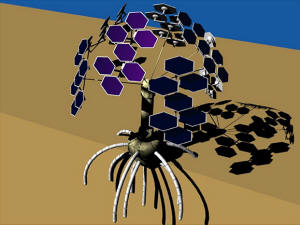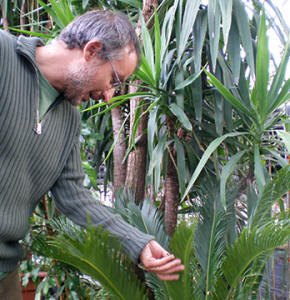|

by Nicole Martinelli
October 30, 2007
from
Wired Website

The "plantoid" is a
concept robot for exploring Mars.
Its roots would
explore the soil,
while power and
telecommunications are provided by the main stem and the solar
"leaves."
Image: Courtesy International Laboratory of Plant Neurobiology
SESTO FIORENTINO, Italy
Professor Stefano
Mancuso knows it isn't easy being green: He runs the world's
only laboratory dedicated to plant intelligence.
At the International Laboratory of Plant Neurobiology (LINV),
about seven miles outside Florence, Italy, Mancuso and his team of
nine work to debunk the myth that plants are low-life.
Research at the modern
building combines physiology, ecology and molecular biology.
"If you define
intelligence as the capacity to solve problems, plants have a
lot to teach us," says Mancuso, dressed in harmonizing shades of
his favorite color: green.
"Not only are they
'smart' in how they grow, adapt and thrive, they do it without
neuroses. Intelligence isn't only about having a brain."
Plants have never been
given their due in the order of things; they've usually been
dismissed as mere vegetables.
But there's a growing
body of research showing that plants have a lot to contribute in
fields as disparate as robotics and telecommunications. For
instance, current projects at the LINV include a plant-inspired
robot in development for the European Space Agency. The "plantoid"
might be used to
explore the Martian soil by
dropping mechanical "pods" capable of communicating with a central
"stem," which would send data back to Earth.
The idea that plants are more than hanging decor at the
dentist's office is not new.
Charles Darwin published
The Power of Movement in Plants
- on phototropism and vine behavior - in 1880, but the concept of
plant intelligence has been slow to creep into the general
consciousness.
At the root of the problem:
assuming that plants
have, or should have, human-like feelings in order to be
considered intelligent life forms, Mancuso says.

Professor Mancuso
blends in with the greenery.
He touches a formerly
neglected office plant.
Photo: Nicole Martinelli
After the folksy 1970s
hit book and stop-motion film
The Secret Life of Plants, which
maintained, sans serious research, that greenery had feelings and
emotions, the scientific community has avoided talking about smarty
plants.
So while there has been a bumper crop of studies demonstrating that
green matter can be nearly as sophisticated as gray matter --
especially when it comes to
signaling and
response systems, few talk
about intelligence.
To christen the lab in 2004, Mancuso decided to use the
controversial term "plant
neurobiology" to reinforce the idea that plants have
biochemistry, cell biology and electrophysiology similar to the
human nervous system. But although LINV is part of the University of
Florence - where Mancuso teaches horticulture - funds for this
fertile field of research weren't forthcoming.
Studies at LINV were eventually given lymph - 1 million Euro so far,
with about 500,000 Euro to come - from the
Ente Cassa di Risparmio di Firenze,
a bank foundation that mainly supports cultural events and art
restorations.
What convinced them to provide seed money?
"Looking beyond the
name at the research," says Paolo Blasi, a physics professor at
the university who's on LINV's board of directors.
"It sounds almost
like a pseudoscientific field, but now even skeptics are
convinced because of the validity of the work."
In addition to studies
on
the effects of music on vineyards,
the center's researchers have also
published papers on gravity
sensing, plant synapses and long-distance signal transmission in
trees.
One important offshoot
of the research activity is an
international symposium on
plant neurobiology. Next year's meeting will be held in Japan.
Leopold Summerer, advanced-concepts team coordinator at the
European Space Agency, remembers that the term "plant
intelligence" raised a few eyebrows when collaboration with the lab
was proposed - even on a multidisciplinary think-tank team that's
used to pondering ideas out of left field.
Nonetheless, Summerer
says plant research may provide important ideas.
"Biometrics can
provide some of the most inspiring resources for us," he says.
"Solutions found by nature that might not seem related to real
engineering problems at first sight actually are related and
give technical solutions."
Radical as the LINV
sounds, if it weren't for a lone sugarcane stalk perched on a
cabinet, the lab looks like any other.
While white-coated researcher Luciana Renna patiently tests
for DNA markers, molecular biologist Giovanni Stefano
analyzes data on two computer monitors around the corner.
During a visit to the lab's two greenhouses - where research is
being conducted on the effects of light on olive trees and reactions
in
Venus flytraps and the
Mimosa pudica - Mancuso points
out a few neglected office plants sent there for a little TLC.
Mancuso, however, is no plant-whisperer.
Under-tended plants are
a long way from understanding sweet nothings spoken softly to them,
he explains.
"Plants communicate
via chemical substances," Mancuso says.
"They have a
specific and fairly extensive vocabulary to convey alarms,
health and a host of other things. We just have sound waves
broken down into various languages, I don't see how we could
bridge the gap."
|


